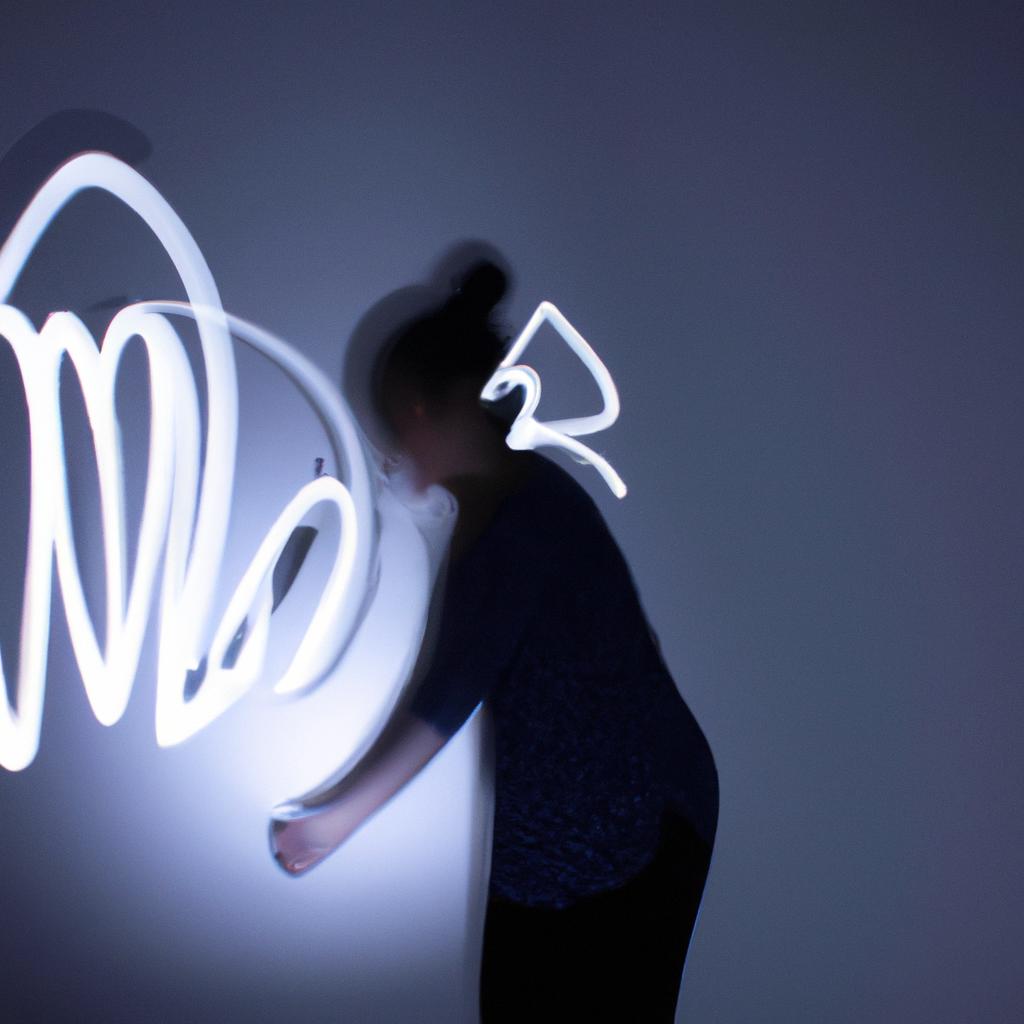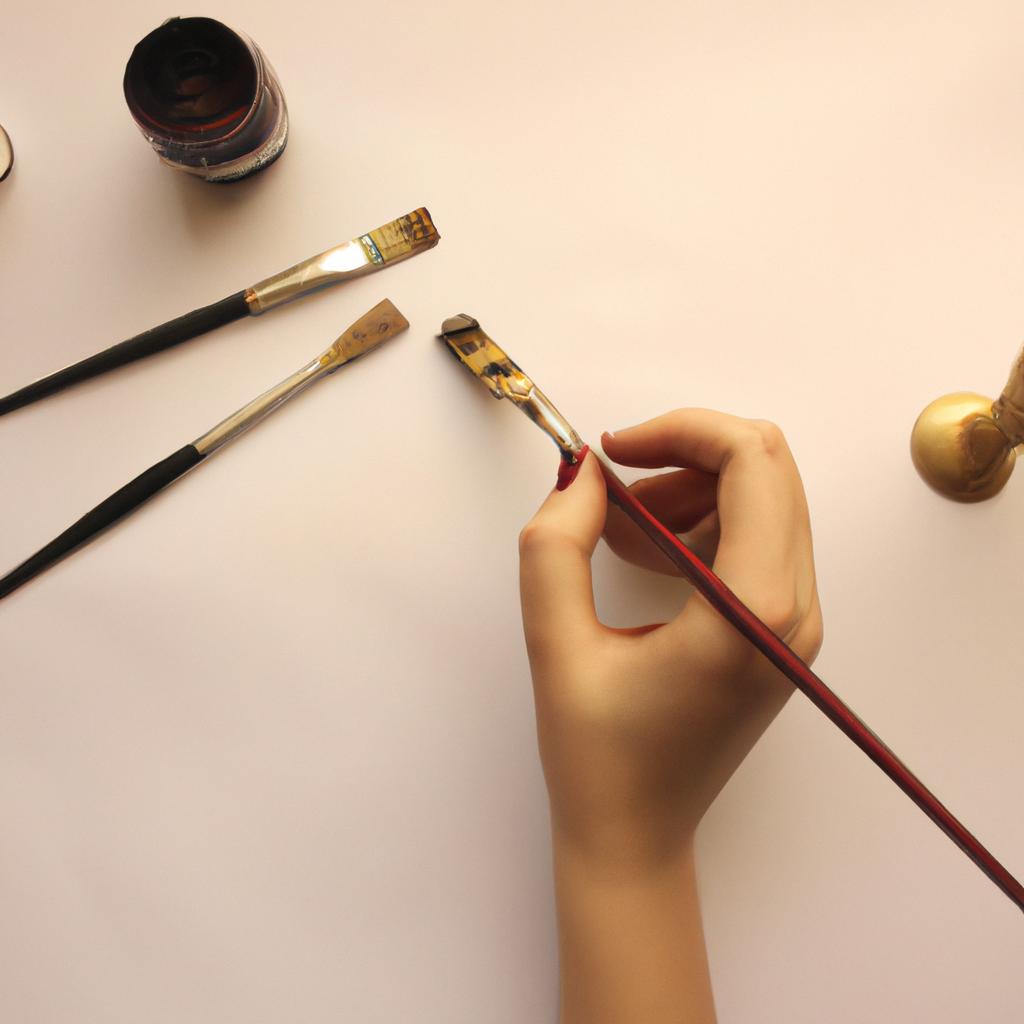Composition in arts and photography plays a pivotal role in the creation of visually captivating and meaningful works. It is an essential element that enables artists to communicate their intended message effectively through arrangement, balance, and organization of visual elements within a frame or canvas. For instance, imagine a painting depicting a serene landscape at sunset; the artist’s skillful use of composition can evoke emotions of tranquility and awe within the viewer. This article delves into the essence of painting by exploring the significance of composition as it pertains to both traditional fine arts and contemporary photography.
In the realm of traditional fine arts, composition refers to the deliberate placement and arrangement of various elements such as lines, shapes, colors, textures, and forms on a canvas or other artistic surfaces. By skillfully manipulating these elements, artists are able to guide viewers’ attention towards specific focal points or areas within their artwork. A classic example illustrating this concept is Leonardo da Vinci’s renowned masterpiece “The Last Supper.” Through his meticulous application of linear perspective and careful positioning of figures around Jesus Christ, Da Vinci managed to create a harmonious composition that draws viewers’ gaze directly towards the central figure while simultaneously conveying a sense of depth and spatiality.
Similarly, composition holds immense importance in contemporary photography. Photograph Photographers use composition to frame their subjects, create visual interest, and convey a specific mood or message. They make deliberate choices regarding the placement of objects, the use of lines, shapes, colors, and patterns within the frame to produce compelling images. For example, in a portrait photograph, the photographer may position the subject off-center using the rule of thirds to create balance and draw attention to their eyes or other important features.
Composition also helps photographers tell a story or evoke emotions. By carefully arranging elements within the frame, they can guide viewers’ eyes through the image and lead them towards a narrative or focal point. Additionally, photographers often utilize techniques such as leading lines or framing to create depth and add visual interest to their photographs.
Overall, whether in traditional fine arts or contemporary photography, composition is an essential tool that allows artists to orchestrate visual elements in a way that communicates their intended message effectively and captivates viewers.
The Elements of Composition
When it comes to creating a captivating piece of art or capturing the perfect photograph, understanding the elements of composition is essential. By carefully arranging various visual components, artists and photographers can guide the viewer’s eye and evoke specific emotions. To illustrate this concept, consider a hypothetical case study involving two landscape photographs: one with poor composition and another with well-executed composition.
In the first photograph, the lack of attention to composition is evident. The main subject, a beautiful mountain range, appears unimpressive due to its placement in the center of the frame without any supporting elements. The absence of leading lines or points of interest fails to engage viewers, resulting in a mundane image that leaves them feeling detached from the scene.
On the other hand, in the second photograph, an artist has employed several key elements of composition effectively. A diagonal line leads viewers’ eyes from the foreground to a striking focal point—the majestic mountains bathed in warm sunlight—creating a sense of depth and dynamism. Additionally, by following compositional guidelines such as the rule-of-thirds and utilizing contrasting colors between sky and land, this photograph successfully stirs up feelings of awe and tranquility.
To further highlight how composition impacts emotional responses, we can examine a bullet-point list:
- Proper use of balance creates harmony within an artwork.
- Strategic placement of subjects directs focus towards important areas.
- Effective utilization of color contrast enhances visual impact.
- Thoughtful incorporation of leading lines guides viewers through an image.
Moreover, let us explore these aspects using a table:
| Element | Effect | Example |
|---|---|---|
| Balance | Creates harmony | Symmetrical vs asymmetrical compositions |
| Subject Placement | Directs focus | Rule-of-thirds |
| Color Contrast | Enhances impact | Complementary colors |
| Leading Lines | Guides viewer’s eye | Diagonal lines |
Understanding the significance of composition sets the foundation for further exploration into other elements within visual arts and photography. In the subsequent section about “Understanding Line and Shape,” we will delve deeper into how these fundamental components contribute to the overall impact of an artwork or photograph, seamlessly building upon our comprehension of composition.
By recognizing that proper arrangement can transform an ordinary image into a captivating masterpiece, artists and photographers gain valuable insight into evoking emotions through their work.
Understanding Line and Shape
Transitioning from the previous section that explored the fundamental elements of composition, we now delve into a deeper understanding of line and shape in the realm of artistic expression. To illustrate this concept, let us consider an imaginary painting by renowned artist Emily Thompson titled “Harmony Unveiled.” In this masterpiece, Thompson skillfully utilizes various compositional techniques to evoke a sense of balance and harmony.
Line plays a crucial role in conveying movement, depth, and emotion within a work of art. In “Harmony Unveiled,” Thompson employs dynamic lines to guide the viewer’s gaze across the canvas, creating a visual journey through intersecting shapes and forms. By manipulating linework with precision and intentionality, she constructs a symphony of strokes that captivate spectators’ attention while reinforcing the overall theme of interconnectedness.
Shape acts as another essential element in composition, allowing artists to define their subjects and establish relationships between different objects or figures within a piece. For instance, in “Harmony Unveiled,” Thompson expertly incorporates both organic and geometric shapes to convey a profound sense of unity amidst diversity. The juxtaposition of fluid curves against angular forms serves not only to emphasize individual elements but also underscores their interdependence—a testament to the power of harmonious coexistence.
To further grasp the significance of composition in painting, it is vital to recognize its emotional impact on viewers. Consider these four key aspects:
- Balance: Achieving equilibrium between various elements instills a feeling of stability and order.
- Proportion: Proper scaling creates an aesthetic harmony that resonates with our innate sense of beauty.
- Contrast: Dynamic variations heighten visual interest by highlighting differences or similarities.
- Rhythm: Repetition establishes patterns that engage viewers rhythmically, evoking a sense of flow.
Moreover, understanding how these emotional responses are intricately woven into artistic compositions can be better illustrated through a table:
| Aspect | Emotional Response |
|---|---|
| Balance | Stability |
| Proportion | Harmony |
| Contrast | Intrigue |
| Rhythm | Flow |
In summary, the essence of painting lies in its composition—a skillful arrangement of lines and shapes that captivates viewers’ attention while eliciting emotional responses. As we transition into our subsequent section exploring the role of color in composition, it becomes evident that each element intertwines seamlessly to create a harmonious visual experience for art enthusiasts and photographers alike.
Next Section: The Role of Color in Composition
The Role of Color in Composition
In the previous section, we explored the fundamental aspects of line and shape in composition. Now, let us delve into another crucial element that contributes to creating captivating artworks: color.
Color plays a significant role in how viewers interpret and engage with a piece of art. To illustrate this, consider the following example: Imagine a photograph depicting a serene landscape during sunset. The vibrant hues of red, orange, and pink create an atmosphere of tranquility and warmth, evoking feelings of relaxation and contentment. In contrast, if the same scene were captured in grayscale or muted tones, it would elicit a completely different emotional response from the audience – perhaps one characterized by somberness or nostalgia.
To better understand the impact of color on composition, here are some key points to consider:
- Color theory: Familiarize yourself with basic principles such as complementary colors (e.g., blue and orange) and analogous colors (e.g., green and yellow). Understanding these relationships can help you effectively use color to convey different moods or emotions.
- Color symbolism: Colors often carry symbolic meanings across cultures. For instance, red may be associated with passion or energy while blue might signify calmness or melancholy. Utilizing these associations intentionally can add depth and layers of interpretation to your artwork.
- Contrasting elements: Experimenting with contrasting colors can create visual interest within your composition. Pairing warm colors like red with cool ones like blue can generate dynamic tension that captures attention.
- Color harmony: Strive for balance when working with multiple colors in your piece. Consider using techniques such as color schemes (monochromatic, analogous) or exploring color harmonies derived from nature (e.g., golden ratios).
By understanding how color influences perception and emotion, artists can manipulate their compositions to evoke specific responses from viewers. Through careful consideration of various color elements, they have the power to guide audiences on an emotional journey through their artwork.
Creating Balance and Harmony
Transitioning from the previous section on “The Role of Color in Composition,” let us now delve into another crucial aspect of composition in arts and photography: creating balance and harmony. By understanding how to effectively arrange elements within an artwork or photograph, artists can guide viewers’ eyes and evoke specific emotions.
To illustrate this concept, consider a hypothetical landscape painting depicting a serene meadow at sunset. The artist carefully arranges various elements such as trees, flowers, and a winding path. Through skillful placement, they achieve a sense of visual equilibrium that evokes tranquility and serenity. This example highlights how balance plays a pivotal role in conveying the intended mood and atmosphere.
When it comes to establishing balance and harmony in composition, there are several key principles to keep in mind:
- Symmetry: Using mirror-like arrangements of objects or shapes can create a sense of stability and order.
- Asymmetry: Balancing unequal elements through strategic positioning can generate dynamic tension while maintaining overall equilibrium.
- Rule of Thirds: Dividing the frame into nine equal sections (3×3 grid) helps determine where focal points should be placed for optimal impact.
- Golden Ratio: Applying mathematical proportions based on Phi (1.618) aids in achieving aesthetically pleasing compositions.
Table Example:
| Principle | Description |
|---|---|
| Symmetry | Mirror-like arrangement creates stability |
| Asymmetry | Unequal elements balanced strategically for dynamic tension |
| Rule of Thirds | Frame divided into 9 sections determines focal point placements |
| Golden Ratio | Mathematical proportions aid in achieving aesthetically pleasing compositions |
Incorporating these principles enables artists to establish visually pleasing compositions that resonate with viewers on an emotional level. When executed effectively, balance and harmony enhance engagement by guiding the viewer’s gaze smoothly throughout the work or photograph.
As we move forward into our exploration of composition, the next section will delve into another crucial element: utilizing space and depth. By understanding how to manipulate these factors, artists can create depth in two-dimensional artworks and photographs, immersing viewers into captivating visual narratives.
Understanding the importance of creating balance and harmony lays the foundation for exploring the utilization of space and depth in composition.
Utilizing Space and Depth
Having discussed the importance of creating balance and harmony in artistic compositions, we now turn our attention to another crucial element that adds depth and visual interest to paintings: texture and contrast. By skillfully incorporating different textures and manipulating contrasts within a composition, artists can evoke various emotions and engage viewers on a more profound level.
To illustrate this concept, let us consider an example of a landscape painting depicting a serene beach scene during sunset. The artist employs smooth brushstrokes with subtle variations in tone to depict the calmness of the ocean water. In contrast, they use thicker impasto techniques to create texture in the sand dunes, allowing for a tactile sense of their roughness. This juxtaposition of smoothness and roughness not only captures the essence of the natural elements but also brings forth an emotional response from the viewer – a sense of tranquility combined with curiosity.
When exploring texture and contrast in compositions, artists employ several techniques to achieve their desired effect:
- Layering: Building up layers of paint or other materials creates depth and dimensionality.
- Collage: Incorporating textured materials such as fabric or paper adds tactile interest.
- Brushwork: Varying brush strokes from soft blending to bold impasto creates contrasting textures.
- Mixed media: Combining different art mediums like photography or sculpture introduces textural diversity.
Furthermore, it is important to understand how texture and contrast can be visually represented within a composition. Consider the following table:
| Element | Texture | Contrast |
|---|---|---|
| Color | Smooth vs. Textured surfaces | Light vs. Dark |
| Shape | Soft curves vs. Angular edges | Large vs. Small |
| Line | Thin lines vs. Bold strokes | Straight vs. Curved |
| Form | Flat areas vs. Sculptural relief | Symmetrical vs. Asymmetrical |
By utilizing these elements effectively, artists can create a visual language that resonates with viewers on an emotional level.
As we delve deeper into the exploration of texture and contrast in artistic compositions, it becomes evident that each stroke of the brush or application of materials holds significance. By thoughtfully considering how different textures interact and employing contrasting elements within their artwork, artists have the power to evoke powerful emotions and captivate audiences. In our subsequent section, ‘Exploring Texture and Contrast’, we will further examine specific techniques used by photographers to achieve similar effects in their work.
Exploring Texture and Contrast
Building upon the concept of utilizing space and depth in composition, another crucial element to consider when creating a visually engaging artwork or photograph is texture and contrast. By carefully manipulating these elements, artists can evoke emotions and captivate viewers, drawing them into the intricate world depicted within the piece.
Texture plays a vital role in stimulating visual interest and enhancing the overall sensory experience of an artwork. It refers to both the tactile quality of surfaces portrayed as well as the illusion of texture created through artistic techniques. For instance, imagine a landscape painting where the artist skillfully depicts rough tree bark using thick impasto brushstrokes. This not only adds depth to the image but also invites viewers to imaginatively touch and feel the ruggedness of nature’s textures.
To further illustrate this point:
- In photography, capturing contrasting textures such as smooth silk against coarse sandpaper can create a dynamic interplay that grabs attention.
- Artists can experiment with various materials like collage or mixed media to introduce different tactile qualities into their work.
- The use of chiaroscuro technique, emphasizing light and shadow contrasts, accentuates texture by casting dramatic highlights and deep shadows across objects.
- Employing complementary colors side by side creates vibrant visual energy while simultaneously highlighting textural variations within a composition.
As we delve deeper into understanding how texture and contrast contribute to impactful compositions, let us explore its effects on viewer perception through an emotional lens:
| Emotion | Texture | Contrast |
|---|---|---|
| Serenity | Soft and gentle | Subtle shades |
| Intensity | Rough and rugged | Stark extremes |
| Intrigue | Varied surfaces | Bold juxtapositions |
| Nostalgia | Weathered patina | Faded tones |
By thoughtfully combining various textures and employing contrasting elements within a composition, artists have the power to evoke a range of emotions within their viewers. The interplay between smooth and rough surfaces, subtle gradations and stark contrasts, can transport the audience into different states of mind, generating a deeper connection with the artwork.
In summary, texture and contrast are integral elements in composition that enhance visual interest and emotional impact. Through skilled manipulation of these elements, artists create captivating works that invite viewers into immersive sensory experiences. By exploring diverse textures and utilizing contrasting characteristics, artists have the potential to elicit an array of emotions and forge lasting connections with their audiences.
 Balazo Gallery
Balazo Gallery



